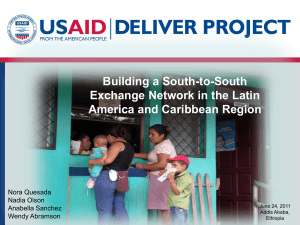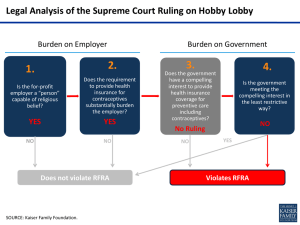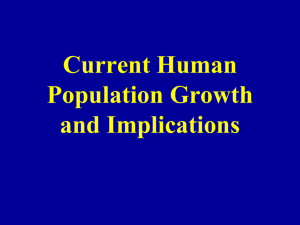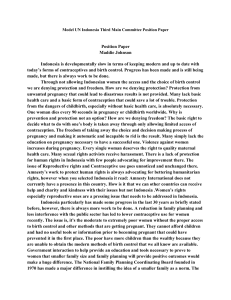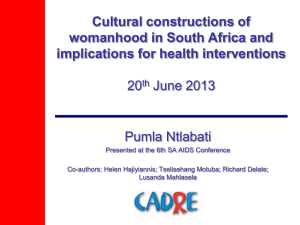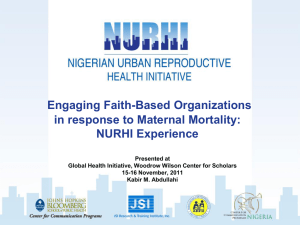Adolescent Reproductive Health Education and Skills
advertisement
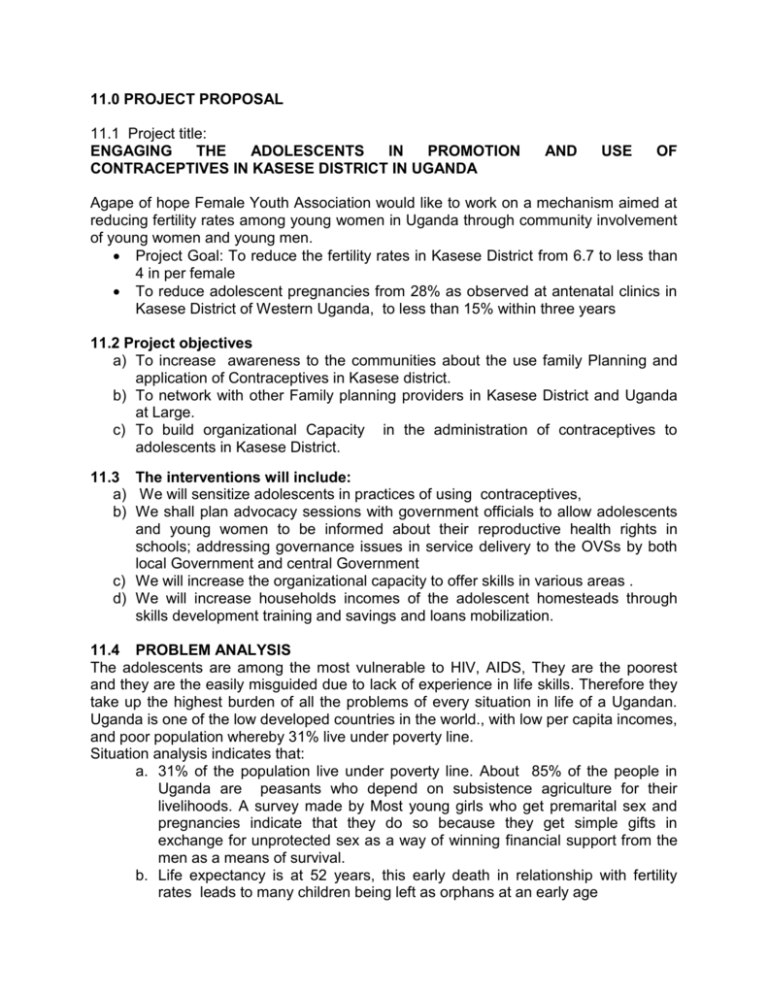
11.0 PROJECT PROPOSAL 11.1 Project title: ENGAGING THE ADOLESCENTS IN PROMOTION CONTRACEPTIVES IN KASESE DISTRICT IN UGANDA AND USE OF Agape of hope Female Youth Association would like to work on a mechanism aimed at reducing fertility rates among young women in Uganda through community involvement of young women and young men. Project Goal: To reduce the fertility rates in Kasese District from 6.7 to less than 4 in per female To reduce adolescent pregnancies from 28% as observed at antenatal clinics in Kasese District of Western Uganda, to less than 15% within three years 11.2 Project objectives a) To increase awareness to the communities about the use family Planning and application of Contraceptives in Kasese district. b) To network with other Family planning providers in Kasese District and Uganda at Large. c) To build organizational Capacity in the administration of contraceptives to adolescents in Kasese District. 11.3 The interventions will include: a) We will sensitize adolescents in practices of using contraceptives, b) We shall plan advocacy sessions with government officials to allow adolescents and young women to be informed about their reproductive health rights in schools; addressing governance issues in service delivery to the OVSs by both local Government and central Government c) We will increase the organizational capacity to offer skills in various areas . d) We will increase households incomes of the adolescent homesteads through skills development training and savings and loans mobilization. 11.4 PROBLEM ANALYSIS The adolescents are among the most vulnerable to HIV, AIDS, They are the poorest and they are the easily misguided due to lack of experience in life skills. Therefore they take up the highest burden of all the problems of every situation in life of a Ugandan. Uganda is one of the low developed countries in the world., with low per capita incomes, and poor population whereby 31% live under poverty line. Situation analysis indicates that: a. 31% of the population live under poverty line. About 85% of the people in Uganda are peasants who depend on subsistence agriculture for their livelihoods. A survey made by Most young girls who get premarital sex and pregnancies indicate that they do so because they get simple gifts in exchange for unprotected sex as a way of winning financial support from the men as a means of survival. b. Life expectancy is at 52 years, this early death in relationship with fertility rates leads to many children being left as orphans at an early age c. Gender Based Violence in Uganda is at 68% for females and 20% for males. This type of violence becomes hard to control when it is at domestic level. The effects can be observed when the children fail to get parental guidance and care, which results into street children and uneducated youth at the end. d. Fertility rates are high in Uganda at 6.7 per women. Only 18% of the married women apply modern contraceptive methods. This is because of lack of nearby facilities but also due to lack of education about them. 435 out of 100,000 women die while producing. This is because of low antenatal health care services. Records at most hospitals indicate that 28% of the women who attend to antenatal clinics in Uganda are below 18 years old. Such young girls, despite the fact that they are supposed to care for their babies, they are not allowed under the international labor laws to have gainful employment e. According to the UNHS 2005/06 more than 2.1 million children in Uganda are vulnerable which represents up to 13. 1% of the young people in Uganda. According to the records of Uganda beauroux of Statistics (UBOS) up to 3 million children in Uganda are under the category of OVCs and 109,000 children of below 15 years Living with HIV are 2.1million vulnerable children and 2.3million orphans (national development plan 2010/11 -2014/15) f. Primary school retention is 53% for boys and 42% for girls while secondary education only 30% of the girls who go to primary schools reach secondary school education at the age of 18 years old. (quoted from UDHS 2009) The high drop out of girls at schools leads to early marriages and unwanted pregnancies at an early age g. HIV prevalence used to be very high; it has been reduced from 30% in eighties to 6-7% in 2008. h. The laws of Uganda condemn any sexual relationships with women who are below 18 years; it also condemn any women who aborts a pregnancy which may arise under such circumstances. i. The churches in Uganda do not allow the use of contraceptives as part of their norms. j. Uganda ranges high in corruption. Although the in national development plan, the Uganda Government has offered to educate OVCs, this money may end up in the pockets of some people or it may end up educating the well to do. It also goes with a cost sharing in terms of scholastic materials, food and uniform which poor parents cannot afford. Kasese district like the rest of Uganda has been having high fertility rates leading to very high population increase of 4.7 per annum. Below is population data extracted from the census results. An estimated figure for the 2010 population indicates a drastic increase, as compared to the available resources, mainly the land. Table showing the population of Kasese District since 1980 Parameters 1980 1991 2002 2010 estimate Population Proportion of the total national population Population Density Mean House Hold size Population growth rate per annum Number of house holds Population in the rural Areas Population in the urban areas 277,697 2.2 343,601 2.06 532,993 2.15 95 118 183 5.1 4.7% 103,060 473,857 59,136 769,600 Bellow is the population data of Uganda 2010, according to Uganda Beauroux of Statistics (UBOS) Demographic and socio-economic statistics According to the 2002 census, in 2002 Population was 24.2 million persons Annual Population growth rate between 1991 and 2002 censuses was 3.2 percent 2002 population density was 123 persons /Sq.Km 49 percent of the population was below 15 years Total Fertility Rate (UDHS 2006) was 6.7 Births per woman Infant Mortality Rate (UDHS 2006) was 76 Per 1,000 Live births The projected 2010 mid-year population stands at 31.8 millions The social and economic impact of high population growth has resulted into a) land fragmentation b) Increased economic pressure to family heads c) High dependency rates with more than 60% of the population of Uganda being teenagers who cannot be employed, especially the female youth. d) Low tax base at government level. e) High population pressure on the available land. The reason behind the high fertility rates and increased population is due to peoples attitudes and sexual behavior that make it favorable for producing many children. a) The religions in the area do encourage their congregation to “produce and fill the earth” b) The tradition is that women must be submissive to men for sexual intercourse whenever they feel they need them irrespective of whether it is the days of fertilization. c) The girls regard their sexual relations with men as a source of livelihood and they struggle to get into loose marriages as early in life as possible, d) Girls and men feel the only way to maintain a relationship is through having children, so girls or men must struggle to get the habit of producing as a way to increasing family cohesiveness. e) The people are aware of family planning and the existence of contraceptives but they believe if you stop the women from producing it is likely to reduce their life span. f) The communities get a lot of rumors about the counter effects of contraceptives, and it is these untrue stories that discourage the women from using contraceptives. g) The available family planning service providers spend most of their time at the health facilities and they don’t go in to sensitize the communities about it. h) The greatest part of the population are young girls and those who are of age are over 40% illiterate. They cannot read and interpret written information about family planning and cant access contraceptives. Adolescent girls/ young women are faced with many challenges in our community which are but not limited to the following; Increasing unwanted pregnancies among adolescent youth which has been leading to suicidal abortions. The abortion is a crime in Uganda that calls for many years of imprisonment and whoever does it, applies unprofessional methods, According to one professor gynecologist in Uganda, up 6000 ladies died while aborting in the year 2008, and many other abortions resulted into uterine disorders. That adolescent girls and young women are presumed by elder men to be free from HIV/AIDS, therefore they turn out to be a target by many ‘older’ men for sexual abuse, which increases their vulnerability to HIV/AIDS, early pregnancies, early marriages, high school drop- outs for the girl children in our community. ‘Something for Something Love’ Syndrome (exchange of sex for gifts or money) is increasingly contributing to moral degeneration among the adolescent girls/young women whereby they are being enticed into sex by the well to do/the financially able men who offer them gifts or money or lifts and later demand sex. These men take advantage of the girls’ lack of basic needs for survival. The increasing Obstetric Fistula among girls due to early pregnancies- where the head of the baby exerts high pressure to the birth canal of the young mother by creating a hole between the vagina and the urethra allowing constant passage of urine which is uncontrollable. These girls/ victims of fistula feel shy, fear to associate with others, are forced to divorce and work in isolation. Increasing poverty levels among young women and adolescent girls has played a major role in increased early premarital sexual relationships and or early marriages .which exposes them to the risk of getting early pregnancies, acquisition of the HIV virus and other sexually transmitted diseases. 11.5 Major challenges in service delivery include: Some men and women believe they must produce as many children as their bodies can allow. Some women and men believe in children as a center of attraction to their spouses while others take it as a source of bride. wealth Some men and women have a negative attitude towards contraceptives due to some side effects which attach them, Some women dry up in their virginal walls and they lose libido while don’t. Some change their behaviour and these changes in behaviour sometimes turn out to cause domestic violence in stable families; the increased period during menstruation scares some women, the deposited increase in the length of time to conceive after withdrawing from the contraceptives scares many who end up as victims. Some women increase weight immediately after getting started with the contraceptives which may lead to hypertension. Other challenges are the insufficient counselling services that lead women to go in for witchcraft as an alternative and some of them believe in the use of herbs and magic for birth controls. Women have to go far to hospitals to access the Long Term Acting Methods which are not available due to lack of technicians. Those who understand family planning are few and most of them cannot put aside money for that purpose. The people are generally poor and the health centres cannot raise the money to serve the communities with family planning services. 11.6 Project Justification The major area of interest is reducing the fertility rates as a way to reducing family burdens, increasing available time for women labor and increasing household incomes leading to better standards of living Many healthy workers who have been offering family planning services in Kasese District have not had remarkable impact, the fertility rates continue to increase, while the population increase rate is at its high level. This is because the family planning units which are in place concentrate in health centers which are visited by the few who are not healthy. The association would like to use the community in approach reduction of fertility rates. This is intended to examine and change the attitude, practices and behavior of people. It is intended to attract the young men involvement in the drive towards reducing fertility rates of young women. It is also intended to approach the young women to reduce their urge for early marriages, and early sexual interests as a way to reduce their active reproductive period. The project is aimed at using community based structures to sensitize their fellow community members to understand family planning and the available contraceptives. We will engage the attendants in drug shops to train in the management of contraceptives, and the use of the available family planning methods. This approach is intended to reach all the people through their own community structures to destroy the wrong impression of the people about contraceptive use and family planning. The project officer will use the radio, the community cultural and religious leaders, the school teachers, The traditional birth attendants (TBAs) the village leaders to sensitize the people about the application of contraceptives. The project staff will be trained in the application of Long Acting and Permanent methods of family planning, as a way to bring the service nearer to the people. 11.7 Service coverage and community needs 11.7.1 Current services that are available at the Health Center for application of contraceptives Contraceptive use is being mainstreamed along with immunization programs of children which funded by UNICEF 11.7.2 Current family planning provider in Kasese district Three health center provide Family planning service in Kasese Municipality and the surrounding 4 sub counties, These include Bishop Masereka Health Center, St. Pauls Health center, Kasese Town Health Center, and Kilembe Hospital. The population to be covered is about 700,000 peoples half of whom live in the municipality of Kasese. However most health centers which provide family planning services are under the control of Religious leaders who do not allow the use of contraceptives in real life. 11.7.3 Key Gaps The service providers are insufficient for the 700, 000 people who live in Kasese District. The contraceptives are insufficient. The available health centers require more contraceptives. While most people are aware of the family planning as use of contraceptives but they attach different views to it. There is need for intensive education of the potential users of contraceptives to ensure they can control their birth. 12.0 Areas of intervention Our proposed intervention will mainly concentrate on methods of reducing fertility rates in adolescents and all women in general as a method towards reducing economic burdens and social problems at household level. It is through sensitization that the adolescents will be trained in the practice of using of contraceptives, through lobbying local government authorities We also plan lobby the parliament of Uganda through our local area Members of parliament, to allow young women to do away with unwanted pregnancies. This will require to change cultural beliefs, norms and practices that perpetuate increased fertility rates. . 13.0 Proposed Strategies to support young women /adolescent girls’ empowerment: Training of adolescents in various skill areas like tailoring, knitting, cosmetology, food preservation, crafts to mention but a few. to help them earn income. Training the young women /adolescent girls on human rights promotion (women’s rights, domestic violence prevention, child abuse prevention) Formation of Community Peer Educators to continue training others/ sensitizing their communities. Training on the prevention of Obstetric Fistula and supporting victims of Fistula with start- up kits for initiating individual projects at household levels for income generating. Sensitizing the adolescents in schools and out of school about the practice of using contraceptives in birth control and prevention of HIV/AIDS 13.1 Key strategies 1) To Franchising with the available private sector (drug shops) and village health teams (VHT) in service delivery of contraceptives to the adolescents and the entire community. 2) To Form community based structure of change makers to continuously provide counseling service and psychosocial support to those who are applying the contraceptives. 3) To Sensitize communities , through community dialogues and establishing community norms that favor family planning. 4) To establish linkages with communication networks to offer on line advisory services on contraceptive use and other family planning issues 14.0 PLANNED ACTIVITY The Association would like to strengthen the family planning that is already in place to cover the whole of Kasese District along with. the other long term players who have been maintaining family planning units in Kasese District through community involvement,. The project is aimed at sensitizing family heads towards: a) keeping manageable family size, b) reducing early teenager pregnancies, reducing on the number of unwanted children. and infant maternal death. c) reducing abortions by adolescents and related death of young girls. d) reducing population pressure on the available land. e) Increasing the quality of life in families. 14.1 Bimonthly outreach activities The association will conduct bi-monthly outreach activities to the communities, Out reach centers will be established at parish level, in the urban and the very rural areas within Ksese District., We will begin in first year by operating in Kasese Municipality and three neighboring Sub county lower local Government areas. Second year we will move to 5 other sub counties, and in third year, and five others in the third year. The project coordinator will utilize the existing community pear educators (CPEs) who are already located at village level. The Association already has 45 volunteer pear educators located in Kasese Municipality. We will need 10 CPEs in Each of the 16 lower local Governments where the project will be implemented. The CPEs Will be working with one health worker who will be appointed for project implementation. The project Coordinator will be assisted by the community leaders in the selection criteria to select the new CPEs. who will be women and men from families that practice family planning methods like the use of contraceptives. 14.2 Family planning competition. Under the project we will organize all those families which practice the use contraceptives. The elected families will be organized into village groups by the CPEs, for purposes of continuous counseling and receiving supplies of the same. We will register and reward long term users of contraceptives and they will also work in communities as change makers. Those families with long experience of using contraceptives will be rewarded with certificates of merit and some gifts, and some gifts. 14.3 For capacity building we will hold various workshops and seminars a) Orientation workshop Two day orientation workshops for the Community Pear Educators and the staff will be held at the beginning of every year of the project. The participants will be divided into groups of 50. Two clinical officers will be used and they will also undergo training for 2 weeks at a major hospital in the use of Long acting permanent methods (LAPMs) of family planning. b) Workshops for 40 drug shop owners A 2 day training workshop will be held every year, for the drug shop owners to train in the dispensing of contraceptives and counseling of their adolescent clients. The training will be focused on the use of Long acting permanent methods (LAPMs) by adolescents whereby about 40 drug shop owners will be trained. 14.4, Sensitization meetings a) Village community sensitization meetings The Community Peer Educators(CPEs) will hold sensitization meetings at village level to educate the community about contraceptive use. These meetings will be held mainly at school, in mosques and churches and at festivals. The CPEs will also organize various meetings with the out of school adolescents to sensitize them about the importance and use of contraceptives. The meetings will be for the hard to reach people like the bodaboda riders, the taxi drivers, coffee women laborers, the petty traders, Village savings and Loans Association (VSLAs) and other civil society groups. The Community Peer Educators will be required to hold at least one such meeting every month. The meetings will be used for information sharing, understanding the challenges and getting common answers to them. b) Meetings We will hold meetings of stakeholders annually who will include representatives of the local Government leaders, The district local Government leaders,, the lower local Government leaders,, Primary School management committee leaders and head teachers, Health workers, leaders of the private sector and cultural leaders. 14.5 FAQs and Answers Booklets At the community meetings, the Community Peers Educators and the health workers will gather the frequently asked questions about the challenges which the users of contraceptives meet while they apply the various family planning methods. The staff will sit with some technicians in medicine and social sciences to interpret the questions and decide on what can be the possible answers and possible solutions to those questions. Booklets with the highlighted challenges and answers will be edited and 200 copies will be produced and disseminated to stakeholders every year, The books will be useful in the field for users to addressing issues that are related to various family planning methods and in particular the Community Peer Educators in the use of contraceptives. . 14.6 Radio Talk Shows We plan to use the media for continuous sensitization of the young women and men about family planning. We will hold 25 radio talk shows, about contraceptive use in family planning during the first half of each year. Each show will run for 30 minutes. The costs of the shows will include the allowances for the guest speakers who will be called to and talk about the topic, the second category will be the per diem to the coordinator and any other radio presenters. The radio presenters will be requested to have some DJ mentions, make announcements and run some adverts that encourage the young women and men to use contraceptives in family planning. 14.7 Sensitization Songs Other methods of creating awareness to communities will include composing songs that discourage a lot of children on one woman, and those that praise small manageable families. The local artists in Kasese District will be engaged to compose 2 songs every year, in different local languages. The songs will be useful in changing peoples attitudes and practices in family upbringing. We will produce 200 CDs every year which will be disseminated to radio stations, people of influence, people who have commercial music systems, mosques, churches, schools, hotels, bars where it can be played to many peoples 14.8 Debates and essay competitions. We plan have debates to be held in schools, mosques and Churches to debate the challenges that people have about contraceptives in respect to cultural and religious beliefs. The findings from those debates will assist the project management to get direction in the sensitization plan. We will hold 9 debates three years. The debates will be held at places which conduct neutrality to accommodate all cultural leaders, local government leaders, school leaders ,the youth and women leaders. The Discussants will be selected by the project staff. Main Discussants at each debate will include 3 young men and three women. Other people will be called upon to contribute, they will include the religious leaders, local opinion leaders and cultural leaders to bring Hold 6 debates in mosques and churches. Each debate will be attended about 50 people 14.9 Information, communication and Education (ICE) materials We plan to produce, information and communication education (ICE) material like flares, stickers, brochures, posters, T-shirts, burners. We will develop some catch words about family planning methods and print them on stickers which will be disseminated to cars, bodaboda motorcyclists, hotels bars, where they can easily be read. We will bring similar words and pictures on posters which will be put in public places like schools mosques, churches, bars, hotels, markets. Flares and brochures with advising massages and peoples experience will also be placed in public places like banks, public offices where people have a reading culture. We will print T-shirts, which will be put on by staff, change makers and opinion leaders for promoting visibility.. 14.10 On line counseling and guidance The project will introduce on line counseling and guidance through the Community Peer Educators. The communication networks in Uganda will be requested to support this social change through offering their service at a lower rate. Each sub county leader of Community Peer Educators will be provided with a mobile phone which has got a program that can track information about clients that use contraceptives as a method of family planning and be able to liaise with the clinical officers in case of advisory and counseling services to those clients through their telephone linkages. 32 mobile phones will be required whereby 2 phones will be offered to 2 of the Community Peer Educators in each sub county of Kasese district, Each phone will have a solar powered charging solution and accessories, with the new program installed. A Toll free line will be opened for the clients who will wish to get any information about the status in use of contraceptives. Monitoring existing Government Health service providers. The Association will use the Community Peer Educators to monitor the existing distributors of contraceptives and Health Educators about the same. A monitoring tool will be developed to get information about the status quo .in various health center in the District.. The CP Es will deliver quart early reports about the state of affairs. 14.11 HIV AND AIDS MAINSTREAMING As a cross cutting issue, the mainstreaming of HIV and AIDS transmission and prevention will be one of the components of the project. The project workers will be expected to go mentioning the risks and vulnerabilities related to HIV transmission and the preventive methods that are available to avoid HIV infection, 15.0 Table showing the Work plan 1 2 3 4 5 6 7 ACTIVITY (IES) output Conduct bimonthly outreach services for contraceptive education and distribution Hold sensitization meetings at village level on contraceptive use Hold 2 day workshop to Train 32 drug shop owners per year in administration of contraceptives. Hold 2 day workshop of 5 staff and 7 board members for project orientation. Hold 2 day workshop in 2nd year - 5 staff and 7 board members for project review. Hold a 1 day workshop at sub county level, twice to train 100 Community pear educators (in 2 groups) Hold meeting of stake holders (50 people) twice first and third year 6 trips in each of the 10 sub counties per year 4 per sub county (40 in number) 8 9 11 12 13 Hold weekly radio Talk shows for 5 months Compose 2 songs in 1st an 3rd year to sensitize on reducing fertility rates Hold 2 annual event to Sensitize local govt women councilors and other local leaders 50 people each year Develop, Produce and disseminate IEC materials about family planning and contraceptive use Hold music gala to launch campaign on use of contraceptive, and Offer certificates of merit to 100 long term users people) 14 15 Hold meetings at 10 health centers to get the most frequently asked questions about family planning and contraceptive use 1 day Meeting of Staff and some CPEs to Analyze or edit the Questions and answers (12 people) 16 Equipment for the project 17 Monitoring and evaluation 18 End of year Reflection meeting of staff, board and stakeholders for 40 people 19 Quarterly Committee meetings members 20 16.0 HIV and AIDS mainstreaming (purchase of condoms) Targeted area Hole one workshop per year One workshop for staff and board in 1st year One workshop for staff and board in 2nd year Two workshops for CPEs 1st and 3rd year Two meeting for stake holders 1st and 3rd year Hold 45 radio talk shows (15 per year) Two songs every year in 1st and third year Hold two meetings with LG counselors one per year in 1st and 2nd year Produce 1500 stickers, 6 murals, 900 poster, 3000 fliers, 3000 brochures in 3 years Tow music galas, one in 2nd year and another in 3rd year Collect and produce 200 booklets of most frequently asked questions Hold 3 meetings , one every year Procure 1 laptops, 20 mobile phones, 20 bicycles , 1 motorcycles, 2 digital cameras 3 end of year reflection meetings (one per year) Hold 4 committee meetings every year Sensitize the 302 direct beneficiaries Yr 1 x X Yr 2 Yr 3 x x x x X x X Persons responsible Health workers CPEs Health workers Coordinator Coordinator X coordinator X X X X X X X X X coordinator coordinator Coordinator coordinator X X coordinator X X Coordinator X X coordinator X coordinator X X X Coordinator X X X X X X X X X X X X X X X Board and staff Board Health workers and CPEs The outreach services of our Association will cover 13 sub counties and Kasese Municipality in Kasese District, Which covers a population of up to about 600,000 people. We will have outreach centers in village to reach the young women and young men at grass root level. 17.0 Project Management The project will be managed under the Program Coordinator of the Association, The Board will give the policy guidance. The Program Coordinator is the chief accounting officer to the project funds and will be monitoring project sites and compiling monthly reports, The reports will be submitted to the committee by the Program Coordinator and they will include both the narrative and the financial reports: .the narrative reports will be mentioning the challenges mate and the lessons learnt. Project implementation will be done by Program Coordinator, Health workers in the use of contraceptives The staff will spend most of their time in communities, attending meetings, community gatherings, and other functions where they will be sensitizing the communities and dispense the contraceptives as the best practice to family planning. 18.0 Expectation at the end of the project will include: Increased contraceptive use in family planning, from 18% to 30% Increased girl retention in primary schools from 42% to 70% Decreased maternal and child morbidity and mortality. Decreased fertility rates from 6.7 to about 4 per woman. Decreased early pregnancies reported at Hospitals from 20% to 15% Create a sustainable and scalable intervention 19.0 Monitoring and evaluation The Project Coordinator will develop monitoring tools that will be used by the clinical officers to report about the progress made in their field work. The tool will indicate the type of people reached by gender, occupation and general opinion of the respondents about the available family planning methods. The staff will meet by-weekly to review the activities and re-examine the methods of work. The Board will meet quarterly to review the financial and activity reports as presented by the Executive Director and the health offices. 19.1 Follow-Ups And Feedback Routine follow-ups will be done by the Project officer to get feedback from the project beneficiaries and the field staff to ensure they are delivering the correct information. The coordinator will also be initiating dialogue between the beneficiaries and the field staff to get the gaps that may be existing between the two parties. 19.2 Baseline survey As a basis for monitoring and evaluation we will carry out a baseline survey at the beginning of the project that is aimed at getting the exact position of the people in terms of attitude towards the practice of family planning and use of contraceptives. Among the issues to be surveyed ,We will examine the per capita consumption of the contraceptives and the percentage of women who use the contraceptives. The survey will involve 100 cases selected from communities at selected random. All sorts of communities will be surveyed namely, the petty traders, cultural leaders, the officers at police, local governments, heath centers, mosques, churches; the transport section and in markets. An interviewing tool will be developed and the data will be analyzed using the SPSS package. The survey is intended to guide the project implementers to the best method of family planning, and the best approach for sensitization. 19.3 Mid term and End line survey: Mid term and End line survey will be done in the middle and an end line survey at the end of the project to asses the level of attitude towards the practice of family planning and use of contraceptives.. An external evaluator will be hired by the organization to asses the impact and to understand the relationship between the outputs and the inputs in project implementation. The evaluation will guide the community Pear Educators, and local leaders on the values of the intervention. 19.4 Impact assessment The impact will depend on the action taken by stakeholders in taking up the mission to fulfilling the goal. The impact will be visible after a long time. It will be measured by the reduction in pregnancies of school going children, per-capita consumption of contraceptives and men women participation in the distribution of the contraceptives to the people both in urban and rural areas in Kasese District.. 20.0 Financial information 20.1 Previous expenditure 2010 The overall amount spent by the Association last year including all projects and operational costs was UG Shs 16,543,000 equivalent to US $ 8,317 as shown on the table below. Activity 1 2 Training of female youth in adolescent reproductive health Training 45 Community leaders for 10days in adolescent reproductive health Amount in Amount UG Shs in US $ 2,579,000 1,253.9 3,600,500 1,821.2 3 4 Purchase of equipment and tools Administrative costs TOTAL 5,796,500 4,567,000 16,543,000 2,932 2,310 8,317 The exchange rate at the time was at UG Shs 1,977 for the 1 US $ 1.4 The proposed budget for the year Jan. 2012- Dec. 2013 The group plans to spend UG shs 65,939,800 equivalent to US $ 23,978 during the first year of the project.. Whereby we request for a grant of US$ 22,489 worth Ugx 62,295,400 for the first year of the project. The local contribution will be US $ 1,325 Exchange rate is at UG Shs. 2,750 for 1 US $ Table showing the summary budget of the planned project proposal about promotion of use of contraceptives by young women in Kasese District TOTAL 1 ACTIVITY BUDGET GRANT CONTRIBUTION 2 Conduct bimonthly outreach services for contraceptive education and distribution 3 Hold sensitization meetings at village level on contraceptive use (4 per sub county => 16X4 => 64) 2,400,000 2,400,000 4 Hold 2 day workshop to Train 32 drug shop owners per year in administration of contraceptives. 2,420,400 2,420,400 5 Hold 2 day workshop of 5 staff and 7 board members for project orientation. 876,400 876,400 6 Hold 2 day workshop in 2nd year - 5 staff and 7 board members for project review. 7 Hold 1 day workshop at sub county level, twice to 8 train 100 Community pear educators (in 2 groups) 2,798,000 2,798,000 - Hold meeting of stake holders (50 people) twice first and third year 1,786,000 1,786,000 - Hold weekly radio Talk shows for 5 months 5,250,000 4,300,000 950,000 Compose 2 songs in 1st an 3rd year to sensitize on reducing fertility rates 4,000,000 4,000,000 - Hold 2 annual event to Sensitize local govt women councilors and other local leaders 50 people each year 1,796,000 1,346,000 450,000 Develop, Produce and disseminate IEC materials about family planning and contraceptive use 1,420,000 1,420,000 - 9 11 12 13 14 Hold music gala to launch campaign on use of contraceptive, and Offer certificates of merit to 100 long term users people) - - - 2,640,000 2,640,000 - 2,500,000 2,500,000 - 613,000 338,600 275,000 12,150,000 12,150,000 - 16 Hold meetings at 10 health centers to get the most frequently asked questions about family planning and contraceptive use 1 day Meeting of Staff and some CPEs to Analyze or edit the Questions and answers (12 people) 17 Equipment for the project 18 Monitoring and evaluation 19 End of year Reflection meeting of staff, board and stakeholders for 40 people 3,800,000 3,800,000 - 20 Quarterly Committee meetings members 5,650,000 3,680,000 1,950,000 - - - 15,840,000 15,840,000 - 15 HIV and AIDS mainstreaming (purchase of 21 condoms) 22 Human resource TOTAL Ug Shs 65,939,800 62,295,400 TOTAL US$ 23,978 22,653 3,625,000 1,325 More information shall be send to you as you reply this proposal. And after hearing from you. We shall be happy to hear your positive response as we hope to work with you to help our adolescents. You are free to make any correction according to your criteria. Yours truly, Bwambale Elias Co-ordinator
